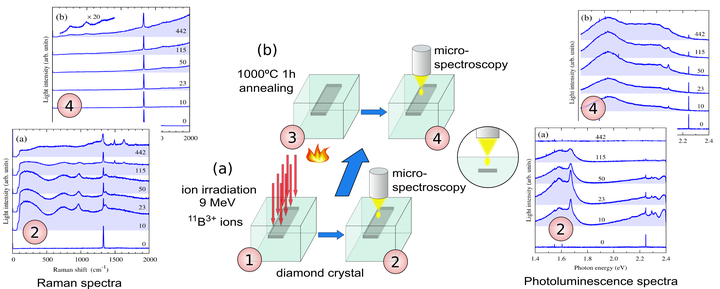Micro-Raman spectroscopy of near-surface damage in diamond irradiated with 9-MeV boron ions

Abstract
We have studied the near-surface damage in a diamond crystal caused by irradiation with swift boron ions and its healing after high-temperature annealing. A diamond crystal was irradiated with 9-MeV $^{11}$B$^{3+}$ ions with fluence values between $1 \times 10^{15}$ and $4.42 \times 10^{16}$ ions/cm$^2$ to generate various levels of lattice damage. The ions loose energy to the lattice and, according to simulations, stop at a depth of about 5 μm, where they form a thin buried implantation layer. For the near-surface layers damage is produced by the ions at high kinetic energy before they slow down. Only intrinsic defects can be produced, with no boron atoms. The lattice damage of the near-surface layers and its recovery after annealing for 1 h at 1000°C were studied by Raman and photoluminescence spectroscopies. Back-scattered light from a 514.5-nm laser beam was collected from the sample surface, probing a depth of a few micrometers. We observe some disordering of the lattice plus the formation of neutral vacancies, interstitial and other lattice defects. After annealing the Raman spectrum shows a significant recovery of the lattice order and the disappearance of isolated neutral vacancies. Residual damage is confirmed by the luminescence spectrum, that shows the appearance of new spectral features.
Full citation:
F. Agulló-Rueda, M. D. Ynsa, N. Gordillo, A. Maira, D. Moreno-Cerrada, and M. A. Ramos,
“Micro-Raman spectroscopy of near-surface damage in diamond irradiated with 9-MeV boron ions,”
Diamond Relat. Mater. 72, 94–98 (2017).
DOI: 10.1016/j.diamond.2017.01.010